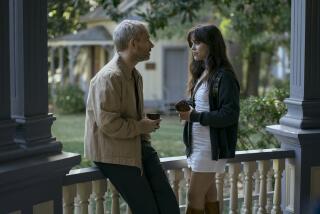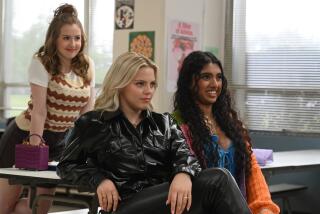Rebellion in ‘Foxfire’ Loses Impact in Leap to the ‘90s
Who said girls just want to have fun? Sometimes, they just want to bond. And they want to bond just like guys. Which is what they’re doing in a mini-rash of movies about young women and adolescent girls rebelling against their restrictive roles and kicking some deserving male butt while they’re at it.
Annette Haywood-Carter’s “Foxfire,” adapted from a Joyce Carol Oates novel and awkwardly transported from the ‘50s to the ‘90s, tells the story of four high school seniors in Portland, Ore., who are united when a young drifter (Angelina Jolie) enters their midst and incites them to physically assault a teacher who’s been sexually harassing his students.
The teacher’s victims include Rita (Jenny Lewis), a passive loner, and Violet (Sarah Rosenberg), a sad girl trying to overcome her low self-esteem by sleeping her way through the high school yearbook. Their comrades in arms (actually, the weapon is a knee) are the stable, self-confident Maddy (Hedy Burress) and Goldie (Jenny Shimizu), who is pot-smoking and self-destructive.
The classroom incident gets the girls suspended for three weeks, giving them time to set up and hang out at an abandoned house and get into more trouble. Soon, they’re breaking into the school and setting off fire alarms, tattooing their chests with an adopted unity symbol, swilling inexplicable supplies of whiskey and confronting a testosterone squad of male bullies. Before they’re through, kidnappings have occurred, guns have been fired, cars have been trashed and the few parents spotted have been demonized.
These are rebels with a definite cause.
The time shift may have been essential to reaching a contemporary audience, but Elizabeth White’s script doesn’t make a smooth transition. Oates was not only writing about teenage girls living in a different time, but also about living with the myths of the time, and those intangibles don’t travel well into the ‘90s.
Jolie’s Legs Sadovsky seems inspired by James Dean’s Jim in “Rebel Without a Cause,” and that’s the way she is introduced to us, as an outsider whose attempts to hide her pain and vulnerability make her seem many times tougher than she is.
Legs steps into the film, literally, with attitude, a pair of black, square-toed boots landing hard on a rain-soaked Portland street. She dresses like a guy, walks like a guy, thinks like a guy. She’s beautiful, she’s sensitive, and, as far as we can tell from as far the filmmakers are willing to go, she’s gay. Her mother’s dead and her father’s unknown, and now she’s alone, heading nowhere. A drifter for the ‘90s, lost but unafraid.
It took a lot of hogwash to develop this character, but Jolie, Jon Voight’s knockout daughter, has the presence to overcome the stereotype. Though the story is narrated by Maddy, Legs is the subject and the catalyst. Teenage girls, who make up the target audience, may find enough to identify with in the other four characters, but for the rest of us the story would be a trial without Legs.
Speaking of trials, the film features a hard rock score that makes the Hard Rock Cafe sound like a recital hall. And speaking of its target audience, good luck getting in. The movie may not be a great success, but it doesn’t deserve to be saddled with an R rating.
* MPAA rating: R, for teen nudity, drug use, strong language and some violent situations. Times guidelines: The film is anti-drug and the nudity is modest.
(BEGIN TEXT OF INFOBOX / INFOGRAPHIC)
‘Foxfire’
Hedy Burress: Maddy Wirtz
Angelina Jolie: Legs Sadovsky
Jenny Lewis: Rita Faldes
Jenny Shimizu: Goldie Goldman
Sarah Rosenberg: Violet Kahn
A Chestnut Hill and Red Mullet Production, released by Samuel Goldwyn Co. for Rysher Entertainment. Directed by Annette Haywood-Carter. Producers Jeffrey Lurie, John Bard Manulis, John P. Marsh. Written by Elizabeth White, based on the novel by Joyce Carol Oates. Cinematography Newton Thomas Sigel. Editor Louise Innes. Production designer John Myhre. Music Michel Colombier. Costumes Laura Goldsmith. Running time: 1 hour, 42 minutes.
* In general release throughout Southern California.
More to Read
Only good movies
Get the Indie Focus newsletter, Mark Olsen's weekly guide to the world of cinema.
You may occasionally receive promotional content from the Los Angeles Times.










